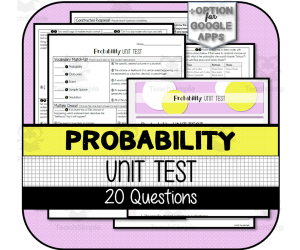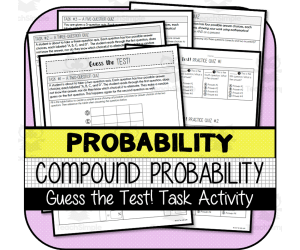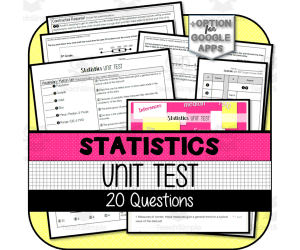2,868 products added recently
Statistics Test
Data Science Fundamentals for Kids - Statistics book
Statistics, Math, Time, Money, Measurements, Fractions, STEM, Homeschool Curriculum, Grade 4, 5, 9, 10, 11, 12, Projects, Activities, Lesson Plans, Teacher Tools, Outlines, Quizzes and Tests, Tests, Worksheets & Printables, Workbooks, Word Problems
Unleash the fascinating world of data science and statistics for children with "Data Science Fundamentals for Kids - Statistics" by Syed Hammad Rizvi. Featuring a detailed 370-page course manual tailored specifically for students from grades 5-12, this invaluable resource simplifies complicated concepts into a series of fun and easy-to-master tutorials. Starting with introductory elements of data types and sources and progressing all the way from advanced concepts of probability studies to visual representation techniques of pictographs, bar graphs, line graphs, pie charts, histograms, and box plots, measures of central tendency of mean, median, and mode statistics, dispersion of range, quartiles, and interquartile range, sampling techniques with simple and stratified sampling methods, concepts of correlation and causality, responsible uses of statistics and ethics in statistics studies, and applied examples of AI and big data statistics analysis, this statistics guide for kids helps instill crucial STEM knowledge for their. Perfect for homeschooling students, this statistics guide for kids also makes for a stellar choice for teachers and scholars seeking resources for statistics learning for children, guidebooks for beginner-level analysis of statistics and frequency analysis for students, books for kids related to STEM information, and resources for probability tutorials for middle school Why Parents/Schools Love It: Engaging and Age-Appropriate Content: Makes use of interesting stories and engaging examples to ease kids into otherwise frightening subject matter involving statistics, thereby giving kids a confidence boost in STEM fields. Comprehensive Skill Building: Encompasses all aspects of analysis from data acquisition to ethical analysis. Aiding students for future AI/data science employment purposes as well as for test preparation. Hands-On Tools/Projects: Includes guides with specific steps for creating illustrations for graphs, calculations for measures of variation, and completion of mini-projects. Encourages Critical Thinking: Teaching the importance of being unbiased, the difference between correlation and causation, and responsible data use helps prepare individuals for the data-intensive world that is the future of business and society. Flexible for Any Learning Style: Can be used for individual study, teaching groups, or supplementing a curriculum, with examples that show statistical principles in sports, games, and real life. Target Grades : Based on the complete analysis of the content, structure, and progression of the book-from very foundational concepts such as "What is Data?" and some simple tally marks in early chapters to more advanced ones like interquartile range, probability laws, sampling bias, correlation scatter plots, and ethical AI implications in later chapters-I believe the book addresses students from grades 5 through 12 most appropriately. The material progresses from simple, kid-friendly explanations using real-life analogies-such as recipes for data organization-to more sophisticated ideas, such as data skewness and mini data projects. As such, it is well-suited for middle schoolers, grades 5-8, who need to study visualization and averages, while high schoolers, grades 9-12, will appreciate the subjects of inference, causation, and what the future of technology holds based on these subjects. It is neither too simplistic for older children nor too advanced for younger ones, and the logic of progression allows for progressive learning. Copyright/Terms of Use This Book is copyrighted to Syed Hammad Rizvi. This resource is intended for home/personal use only. There shall be no changes, modifications, redistributions, or sales of this resource. In other words, it shall not be placed on the Internet where it might be accessible for downloading. “If you’d like to share this resource with fellow teachers, you are able to do so through purchasing additional licenses from Teachsimple.” Este producto llega felices a ofreceros por Syed Hammad Rizvi
Author Creative Book Store
Rating
Tags StatisticsForKids, DataScienceForChildren, STEMEducation, KidsStatisticsBook, DataFundamentals, ProbabilityForKids, DataVisualizationForBeginners, MeanMedianMode, EducationalBooksForKids, Grades5to12
Scatter Plots & Two-Way Tables UNIT TEST
Math, Statistics, Grade 8, Tests, Quizzes and Tests, Teacher Tools
This resource was developed to meet the requirements of the 8th Grade Statistics & Probability Standards below: CCSS.MATH.CONTENT.8.SP.A.1 Construct and interpret scatter plots for bivariate measurement data to investigate patterns of association between two quantities. Describe patterns such as clustering, outliers, positive or negative association, linear association, and nonlinear association. CCSS.MATH.CONTENT.8.SP.A.2 Know that straight lines are widely used to model relationships between two quantitative variables. For scatter plots that suggest a linear association, informally fit a straight line, and informally assess the model fit by judging the closeness of the data points to the line. CCSS.MATH.CONTENT.8.SP.A.3 Use the equation of a linear model to solve problems in the context of bivariate measurement data, interpreting the slope and intercept.For example, in a linear model for a biology experiment, interpret a slope of 1.5 cm/hr as meaning that an additional hour of sunlight each day is associated with an additional 1.5 cm in mature plant height. CCSS.MATH.CONTENT.8.SP.A.4 Understand that patterns of association can also be seen in bivariate categorical data by displaying frequencies and relative frequencies in a two-way table. Construct and interpret a two-way table summarizing data on two categorical variables collected from the same subjects. Use relative frequencies calculated for rows or columns to describe possible association between the two variables.For example, collect data from students in your class on whether or not they have a curfew on school nights and whether or not they have assigned chores at home. Is there evidence that those who have a curfew also tend to have chores?
Author The Math Cafe
Tags Scatter Plots, Two Way Tables, Unit Test, Google Forms, Two Way Scatter Plot, Scatter Plots Worksheets 8th Grade
Probability UNIT TEST
Math, Statistics, Grade 7, Tests, Quizzes and Tests, Teacher Tools
This resource was developed to meet the requirements of the 7th Grade Statistics & Probability Standards below: CCSS.MATH.CONTENT.7.SP.C.5 Understand that the probability of a chance event is a number between 0 and 1 that expresses the likelihood of the event occurring. Larger numbers indicate greater likelihood. A probability near 0 indicates an unlikely event, a probability around 1/2 indicates an event that is neither unlikely nor likely, and a probability near 1 indicates a likely event. CCSS.MATH.CONTENT.7.SP.C.6 Approximate the probability of a chance event by collecting data on the chance process that produces it and observing its long-run relative frequency, and predict the approximate relative frequency given the probability.For example, when rolling a number cube 600 times, predict that a 3 or 6 would be rolled roughly 200 times, but probably not exactly 200 times. CCSS.MATH.CONTENT.7.SP.C.7 Develop a probability model and use it to find probabilities of events. Compare probabilities from a model to observed frequencies; if the agreement is not good, explain possible sources of the discrepancy. CCSS.MATH.CONTENT.7.SP.C.7.A Develop a uniform probability model by assigning equal probability to all outcomes, and use the model to determine probabilities of events.For example, if a student is selected at random from a class, find the probability that Jane will be selected and the probability that a girl will be selected. CCSS.MATH.CONTENT.7.SP.C.7.B Develop a probability model (which may not be uniform) by observing frequencies in data generated from a chance process.For example, find the approximate probability that a spinning penny will land heads up or that a tossed paper cup will land open-end down. Do the outcomes for the spinning penny appear to be equally likely based on the observed frequencies? CCSS.MATH.CONTENT.7.SP.C.8 Find probabilities of compound events using organized lists, tables, tree diagrams , and simulation. CCSS.MATH.CONTENT.7.SP.C.8.A Understand that, just as with simple events, the probability of a compound event is the fraction of outcomes in the sample space for which the compound event occurs. CCSS.MATH.CONTENT.7.SP.C.8.B Represent sample spaces for compound events using methods such as organized lists, tables and tree diagrams . For an event described in everyday language (e.g., "rolling double sixes"), identify the outcomes in the sample space which compose the event. CCSS.MATH.CONTENT.7.SP.C.8.C Design and use a simulation to generate frequencies for compound events.For example, use random digits as a simulation tool to approximate the answer to the question: If 40% of donors have type A blood, what is the probability that it will take at least 4 donors to find one with type A blood? LICENSING TERMS: This purchase includes a license for one teacher only for personal use in their classroom. Licenses are non-transferable, meaning they can not be passed from one teacher to another. No part of this resource is to be shared with colleagues or used by an entire grade level, school, or district without purchasing the proper number of licenses. COPYRIGHT TERMS: This resource may not be uploaded to the internet in any form, including classroom/personal websites or network drives, unless the site is password protected and can only be accessed by students.
Author The Math Cafe
Tags Probability, Unit Test, Google Forms, Probability And Statistics Unit Test Part 1
Compound Probability TASK: Guess the Test!
Math, Statistics, Grade 7, Tests, Quizzes and Tests, Teacher Tools
Compound Probability TASK: Guess the Test! This quality teaching resource targets 7th-grade Mathematics educators with specific emphasis on Statistics. The primary focus is on compound probability tasks, predominantly regarding independent events. Students are offered both entertaining and educational challenges in the guise of a multiple-choice test. Main Features Promotes diligent problem-solving: Students tackle complex compound probability issues, with calculator use strongly advised. Versatile task format: Presents three key tasks based around individual compound likelihood scenarios. Here, students learn to multiply probabilities. In-depth academic engagement: Includes challenge questions and an exploratory challenge segment to foster a deeper understanding and pull learners in. A plethora of applications: Perfect for independent study or group activities, supplemented by optional Guess the Test! quizzes to mix things up. Add-on Features: Guess the Test Dot Plots & Answer Key The 'Guess the Test Dot Plots' allows for interactive classroom discussions post-quizzes. It works by displaying number lines meant for dot plots which helps in assessing student's performance as they mark their scores corresponding to each plot followed by group discussion comparing various quiz results . An answer key is included along side these features making this product even more valuable lending precise guidelines forming correct solutions. Educational Standards Compliance & Licensing Terms This product strictly adheres to 7th Grade Statistics & Probability Standards ( CCSS.MATH.CONTENT.7.SP.C.8 ). It effectively introduces concepts through well-structured lists,tables,and simulations; comprehensive understanding of what they represent; representing sample spaces and identifying outcomes constituenting predefined event circumstances presented in a friendly language. Purchases of this resource grant usage terms that are favorable toward personal classroom use by one teacher only, indicating licenses cannot be transferred from one teacher to another providing secure and nonviolent access to this resource.
Author The Math Cafe
Tags Compound Probability, Independent Events, Multiple-choice Quiz, Calculator Use, Statistics
7th Grade Statistics UNIT TEST
Math, Statistics, Grade 7, Tests, Quizzes and Tests, Teacher Tools
About the 7th Grade Statistics UNIT TEST The 7th Grade Statistics UNIT TEST is a comprehensive tool designed to assess students’ comprehension of 7th grade statistics and probability concepts. It focuses specifically on the use of random sampling for population inferences. This assessment package, equipped with a dual format, comes in both hard copy and Google Forms versions - perfectly suited for traditional classroom settings as well as online or blended learning environments. Question Format and Distribution A variety of question formats such as vocabulary exercises, multiple-choice queries, and constructed response provisions. Inclusive of twenty questions divided into six vocabulary exercises. The distribution comprises: twelve multiple-choice queries, and two constructed responses. Eco-friendly Provisions & Quick Assessment Tools: To aid environmental-friendly practices within classrooms or homeschool environment , separate student answer sheets have been provided which works economical on printing costs. Conveniently included are answer keys with an optional scoring guide for quick assessment from educators' perspective. Effective Usage Strategies: This carefully crafted unit test can be used effectively not only in whole group settings but also serve well within breakout groups or assigned as standalone homework reinforcing key statistical principles assimilation. Proliferation & Value Proposition: With its strong accordance to 7th grade statistics & probability standards, it stands out particularly towards promoting better retention about drawing comparative differences between varied populations; estimating variability between centers by expressing multiple measured variability factors thereby inseminating useful insights. Note:- The product usage involves specific licensing terms mitigating unauthorized sharing across digital platforms without adequate licenses hence ensuring respected Intellectual property rights are diligently respected. Exclusive Access: As part of stringent safety measures, the test is password-protected thereby assuring safe access limited solely to designated students on classroom/personal websites. Make your interaction with undertaking advanced statistics explorations convenient with this thoughtfully crafted resource. The Finer Details: Specially tailored for 7th grade math curriculum making it essential for efficient teaching-learning processes. Focused on the sub-discipline of statistics – a apt addition to your teaching toolkit!
Author The Math Cafe
Tags Statistics, Probability, Assessment, Sampling, Inferences






